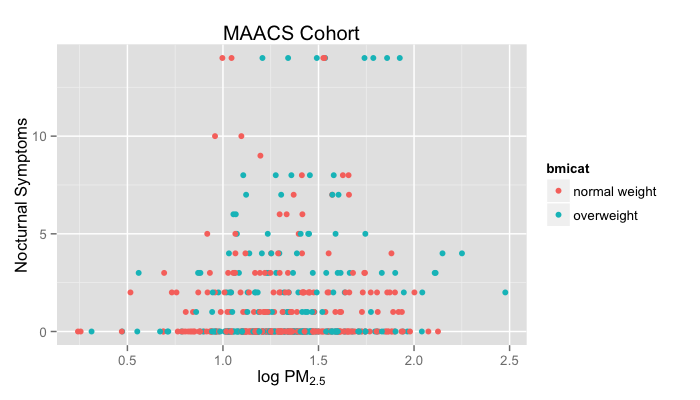---
title : The ggplot2 Plotting System - Part 2
subtitle :
author : Roger D. Peng, Associate Professor of Biostatistics
job : Johns Hopkins Bloomberg School of Public Health
logo : bloomberg_shield.png
framework : io2012 # {io2012, html5slides, shower, dzslides, ...}
highlighter : highlight.js # {highlight.js, prettify, highlight}
hitheme : tomorrow #
url:
lib: ../../libraries
assets: ../../assets
widgets : [mathjax] # {mathjax, quiz, bootstrap}
mode : selfcontained # {standalone, draft}
---
## What is ggplot2?
- An implementation of the __Grammar of Graphics__ by Leland Wilkinson
- Grammar of graphics represents and abstraction of graphics ideas/objects
- Think “verb”, “noun”, “adjective” for graphics
- Allows for a “theory” of graphics on which to build new graphics and graphics objects
---
## Basic Components of a ggplot2 Plot
- A _data frame_
- _aesthetic mappings_: how data are mapped to color, size
- _geoms_: geometric objects like points, lines, shapes.
- _facets_: for conditional plots.
- _stats_: statistical transformations like binning, quantiles, smoothing.
- _scales_: what scale an aesthetic map uses (example: male = red, female = blue).
- _coordinate system_
---
## Building Plots with ggplot2
- When building plots in ggplot2 (rather than using qplot) the “artist’s palette” model may be the closest analogy
- Plots are built up in layers
- Plot the data
- Overlay a summary
- Metadata and annotation
---
## Example: BMI, PM$_{2.5}$, Asthma
- Mouse Allergen and Asthma Cohort Study
- Baltimore children (age 5-17)
- Persistent asthma, exacerbation in past year
- Does BMI (normal vs. overweight) modify the relationship between PM$_{2.5}$ and asthma symptoms?
---
## Basic Plot
```r
library(ggplot2)
qplot(logpm25, NocturnalSympt, data = maacs, facets = . ~ bmicat,
geom = c("point", "smooth"), method = "lm")
```
---
## Building Up in Layers
```r
head(maacs)
```
```
logpm25 bmicat NocturnalSympt logno2_new
1 1.5362 normal weight 1 1.299
2 1.5905 normal weight 0 1.295
3 1.5218 normal weight 0 1.304
4 1.4323 normal weight 0 NA
5 1.2762 overweight 8 1.108
6 0.7139 overweight 0 0.837
```
```r
g <- ggplot(maacs, aes(logpm25, NocturnalSympt))
summary(g)
```
```
data: logpm25, bmicat, NocturnalSympt, logno2_new [554x4]
mapping: x = logpm25, y = NocturnalSympt
faceting: facet_null()
```
---
## No Plot Yet!
```r
g <- ggplot(maacs, aes(logpm25, NocturnalSympt))
print(g)
```
```
Error: No layers in plot
```
---
## First Plot with Point Layer
```r
g <- ggplot(maacs, aes(logpm25, NocturnalSympt))
g + geom_point()
```
---
## Adding More Layers: Smooth
```r
g + geom_point() + geom_smooth()
g + geom_point() + geom_smooth(method = "lm")
```
---
## Adding More Layers: Facets
```r
g + geom_point() + facet_grid(. ~ bmicat) + geom_smooth(method = "lm")
```
---
## Annotation
- Labels: `xlab()`, `ylab()`, `labs()`, `ggtitle()`
- Each of the “geom” functions has options to modify
- For things that only make sense globally, use `theme()`
- Example: `theme(legend.position = "none")`
- Two standard appearance themes are included
- `theme_gray()`: The default theme (gray background)
- `theme_bw()`: More stark/plain
---
## Modifying Aesthetics
```r
g + geom_point(color = "steelblue", size = 4, alpha = 1/2)
g + geom_point(aes(color = bmicat), size = 4, alpha = 1/2)
```
---
## Modifying Labels
```r
g + geom_point(aes(color = bmicat)) + labs(title = "MAACS Cohort") +
labs(x = expression("log " * PM[2.5]), y = "Nocturnal Symptoms")
```
---
## Customizing the Smooth
```r
g + geom_point(aes(color = bmicat), size = 2, alpha = 1/2) +
geom_smooth(size = 4, linetype = 3, method = "lm", se = FALSE)
```
---
## Changing the Theme
```r
g + geom_point(aes(color = bmicat)) + theme_bw(base_family = "Times")
```
---
## A Note about Axis Limits
```r
testdat <- data.frame(x = 1:100, y = rnorm(100))
testdat[50,2] <- 100 ## Outlier!
plot(testdat$x, testdat$y, type = "l", ylim = c(-3,3))
g <- ggplot(testdat, aes(x = x, y = y))
g + geom_line()
```
---
## Axis Limits
```r
g + geom_line() + ylim(-3, 3)
g + geom_line() + coord_cartesian(ylim = c(-3, 3))
```
---
## More Complex Example
- How does the relationship between PM$_{2.5}$ and nocturnal symptoms vary by BMI and NO$_2$?
- Unlike our previous BMI variable, NO$_2$ is continuous
- We need to make NO$_2$ categorical so we can condition on it in the plotting
- Use the `cut()` function for this
---
## Making NO$_2$ Tertiles
```r
## Calculate the tertiles of the data
cutpoints <- quantile(maacs$logno2_new, seq(0, 1, length = 4), na.rm = TRUE)
## Cut the data at the tertiles and create a new factor variable
maacs$no2tert <- cut(maacs$logno2_new, cutpoints)
## See the levels of the newly created factor variable
levels(maacs$no2tert)
```
```
[1] "(0.378,1.2]" "(1.2,1.42]" "(1.42,2.55]"
```
---
## Final Plot
---
## Code for Final Plot
```r
## Setup ggplot with data frame
g <- ggplot(maacs, aes(logpm25, NocturnalSympt))
## Add layers
g + geom_point(alpha = 1/3) +
facet_wrap(bmicat ~ no2tert, nrow = 2, ncol = 4) +
geom_smooth(method="lm", se=FALSE, col="steelblue") +
theme_bw(base_family = "Avenir", base_size = 10) +
labs(x = expression("log " * PM[2.5])) +
labs(y = "Nocturnal Symptoms") +
labs(title = "MAACS Cohort")
```
---
## Summary
- ggplot2 is very powerful and flexible if you learn the “grammar” and the various elements that can be tuned/modified
- Many more types of plots can be made; explore and mess around with the package (references mentioned in Part 1 are useful)















